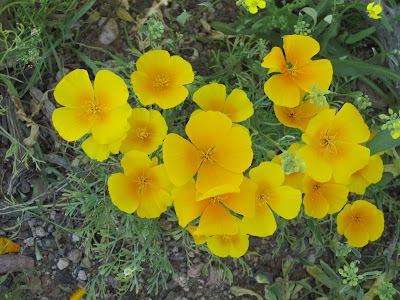Mexican gold poppies, after good winter conditions and rainfall, can provide incredible color displays
as they carpet the desert between late February and mid-April.
Really good displays only happen about every decade or so.
I'm going to put in lots of pictures
because I was so thrilled to experience the blooming of the Mexican gold poppies in Organ Pipe Cactus National Monument (and other parts of Arizona) in a good bloom year.
This was my seventh time there and the first time I have seen the poppies like this.
What a thrill!
I was recently told by a ranger at Organ Pipe Cactus National Monument that they typically need good rains in November and December to get a good bloom. This year, they had no rain in that time frame, but lots of rain in January and February, which has resulted in some spectacular blooms, much to their surprise.
The Mexican gold poppy flower grows on a single stalk
and remains open only in full sunlight.
The flowers are bright yellow
to orange
with four petals that form a cup between 3/4 to 1 1/2 inches wide.
They have fernlike leaves,
about 2 1/2 inches long
and can grow to a height of 16 inches.
They are found below 4,500 feet in elevation from southeastern California to west Texas and into northern Mexico.
It can be poisonous, if ingested. I was told by the ranger that the difference between the California poppy and Mexican gold poppy is that the Mexican poppy is more yellow, it is smaller and it is less hardy.
However, I am also finding an article that says that the Mexican gold poppy is a desert inhabiting subspecies of the California poppy.
.JPG)
.JPG)
.JPG)
.JPG)
.JPG)
.JPG)
.JPG)
.JPG)

.JPG)
.JPG)
.JPG)


.JPG)
.JPG)

.JPG)
.JPG)
.JPG)
.JPG)
They resemble the coastal variant of the California poppy. The maritime ca poppy is shorter/compacted with a more gold flower color than the classic orange CA poppy. These might be a bit leggier than the coastal subspecies but they are certainly gorgeous. I expect there isn't too much difference between all three since they seem to all overlap in ranges and appearances!
ReplyDelete